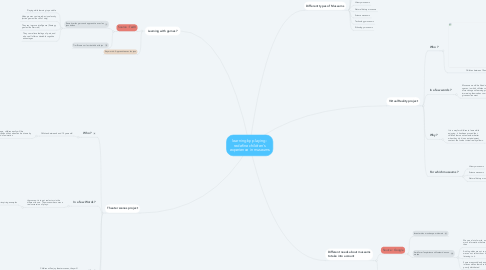
1. Theater scenes project
1.1. Who ?
1.1.1. Children between 6 and 10 years old
1.1.1.1. At this age, children easily will be fascinated and their attention be drawn by this kind of animation
1.2. In a few Words ?
1.2.1. the concept is to put real actors in the different rooms. The museum becomes a real succession of plays.
1.2.1.1. A few inspiring examples
1.2.1.1.1. Principle of Sleep No More in New York (also played in London and Boston). It is an entire building dedicated to Shakespeare's play Macbeth in which the viewer can wander and do whatever he wants (search the drawers, retrieve the papers thrown by the actors ...) as long as he does not hinder the acting and wears a mask.
1.2.1.1.2. The circuit of Lovers of Verdun Puy du Fou, in which we advance in a trench at the same time that we advance in a story
1.3. Why ?
1.3.1. Children will enjoy theater scenes, they will have a different approach of learning than that of traditional way they are teached
1.4. For which museums ?
1.4.1. Art museums
1.4.2. History museums
2. Learning with games ?
2.1. Source : TedX
2.1.1. Remotiver les garcons à apprendre avec les jeux vidéos
2.1.1.1. Playing while learning is possible
2.1.1.2. Video games can improbe visual acuity (action games like call of duty)
2.1.1.3. They can improve intelligence (Strategy games like Starcraft)
2.1.1.4. They can relieve feelings of pain, and above all offer undeniable cognitive advantages
2.1.2. Tim Brown sur la créativité et le jeu
2.2. Key words : Apprendre avec les jeux
3. Different types of Museums
3.1. Archeology museums
3.2. Art museums
3.3. Decorative art museums
3.4. History museums
3.5. Natural history museums
3.6. Science museums
3.7. Technology museums
3.8. Ethnology museums
4. Virtual Reality project
4.1. Who ?
4.1.1. Children between 10 and 14 years old
4.1.1.1. At this age, children can better familiarize with this kind of technology and use it
4.2. In a few words ?
4.2.1. Museums would be fitted with virtual reality spaces, in which children could take part in a discovering and learning program by immersing themselves completely in the given environment
4.2.1.1. A few examples :
4.2.1.1.1. Visualize an historic coronation scene in the courtyards
4.2.1.1.2. Visualize the "prise de la bastille"
4.2.1.1.3. Visualize the escape of casanova in the prisons of sinkers
4.2.1.1.4. Learn some information about prehistoric animals by immersing in a prehistoric environment
4.3. Why ?
4.3.1. It is a way for children to learn while enjoying. it has been proved that children learn and remember better when they do it in an entertainment context. that's what virtual reality allows.
4.3.1.1. some projects of this type already exists : project IMANAYA makes us discover the Bordeaux eighteenth century through a tablet
4.4. For which museums ?
4.4.1. History museums
4.4.2. Science museums
4.4.3. Natural history museums
5. Different needs about museums to take into account
5.1. Source : Google
5.1.1. Inventer des musées pour demain
5.1.2. Améliorer l'expérience utilisateur dans un musée
5.1.2.1. We see a lot of works, and we read too much information that we do not remember then
5.1.2.2. Audio guides are not convenient enough : we can not talk with our friends while listening to it.
5.1.2.3. Some areas suddenly experience very large influxes while others are empty, visitors are poorly distributed
